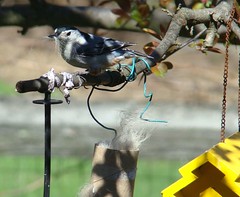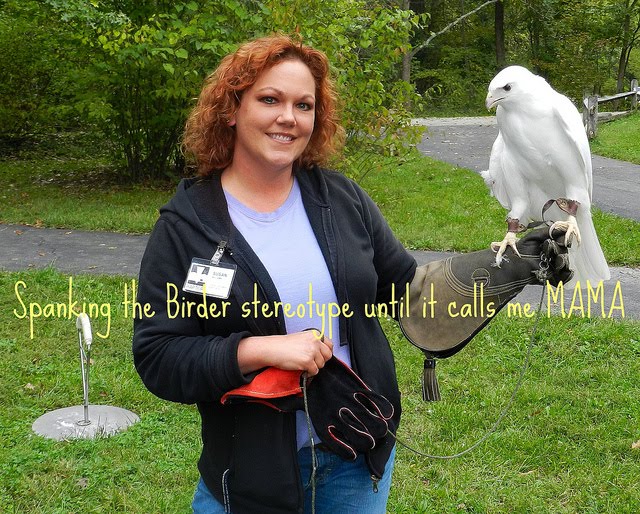Monday, April 27, 2009
We are here
So more will be coming soon....everyone is having a blast!
Saturday, April 25, 2009
Go tell it on the mountain
The husband is armed with clean clothes and instructions.
The girls have promised to be good.
The dogs don't know what is going on.
The cats are asleep on the suitcase.
I'm ready.
West Virginia, prepare thyself.
Friday, April 24, 2009
Come meet the birds!
Come on by and meet our birds!
Tuesday, April 21, 2009
Thwarted pervert? Thief? Or just a really big IDIOT?
I saw him again a few days later and mentioned it to a school staff member.
Didn't hear anything about it.
When I saw him again yesterday, I had just had enough. I demanded answers from a staff member. She took Lorelei into school, and as I was leaving, the GUY pulled out right behind me.
Holy Crap. I drove down to Kroger and parked (better to be around lots of people, I thought to myself). He drove on, not pulling into the parking lot.
Today, as I pulled in to pick up Lorelei, he was there again.
I grabbed the first staff member I saw and told them he was out there. She ran to the director's office, where the director called the police. I ran out, grabbed my binoculars (See? GOOD to be a BIRDER!) and got his license plate number and got a good look at him. I ran back in and gave all the information to the director, who relayed it to the police.
Lorelei and I went back out and sat in the car (with doors locked and engine running) and waited. He left before the police got there....
BUT:
Tonight was the art show at the school, and as we walked in, the director pulled me aside and told me this:
The police found the guy, pulled him over...and found out that the guy was pirating the church's unsecured, wireless Internet signal.
Now. Imagine how it went down. The police swarm this guy's car, thinking he was a child perv, and this guy having to admit that he was stealing from a church.
That's just priceless. I bet I won't be seeing HIM again!
Saturday, April 18, 2009
Bird Banding
Falconers in the Middle Ages would affix plates to their falcons with seals of their owners.
Banding (or "ringing" if you're British) for scientific purposes began in 1899 with Christian Mortensen, a Danish schoolteacher, using zinc rings on European starlings, hawks, storks, etc.
Banding comes in many forms: leg bands, neck collars, radio transmitters, dyeing of feathers and wing tags.
Aside from banding the bird, measurements like weight, toe pad length, wingspan, etc. are collected.
From the USGS:
The first records of banding in North America are those of John James Audubon, the famous American naturalist and painter. In 1803 he tied silver cords to the legs of a brood of phoebes near Philadelphia and was able to identify two of the nestlings when they returned to the neighborhood the following year.
Today, the program stretches from the Canadian Arctic to the tropics of Latin America, from Newfoundland to the far Pacific islands, and beyond to places like Siberia, Greenland, and Antarctica. Wherever North American birds go, bird banding is there.
Virtually all species are, or have been, banded. Currently, 1,200,000 birds are banded, and 85,000 recovered, each year. More than 63,000,000 birds have been banded since the beginning of the program, and 3,500,000 have been recovered and reported to the banding offices. Millions more have been recaptured or resighted by banders.
These banders include federal and state conservation agencies; university associates; avocational ornithologists; bird observatories; environmental centers; nongovernmental organizations; environmental consulting firms, and other private sector businesses. Currently, more than 6,100 banders are operating in US and Canada.
If you are a birder, you know the value of bird banding. The sheer physical abilities of the birds, the distances they travel, their life spans, trends in migration and a species status among a changing environment...all are known thanks to banding.Some fun wild bird banding stats:
Gray catbird banded in Florida was found in Pennsylvania 13 years later.
Atlantic puffin....lived for 31 years, 11 months.
Great Horned Owl...lived for 28 years.
Red-tailed hawk: 28 years, 10 months.
I have a favorite saying, and I wish I knew who coined it. Here it is:
We conserve only what we love.
We love only what we understand.
We understand only what we are taught.
Non-birders or those who have not had the opportunity of this knowledge might have some opinions about banding birds. Maybe they think we are "harassing" wildlife, that we are dooming a bird to die by placing a metal or plastic band to its leg. I'd like to help erase those opinions now.
Bird bands are very light. They are sized appropriately for the species that will wear it. A hummingbird's band weighs less than one-hundredth of a gram! By comparison, a hummingbird wearing a band is the equivalent to a human wearing a wrist watch.
We can't give a bird our phone number so they can call us to report on its whereabouts or how it's doing. A recovered band is invaluable.
Banding is done with the utmost respect given to the bird, and a bird is kept in hand no longer than absolutely necessary.
If there are those who still have doubts about banding, remember this:
We have been banding for 100 years in this country. It's working.
Now, onto some photos from a great horned owl banding:
The one chick in the nest is banded....
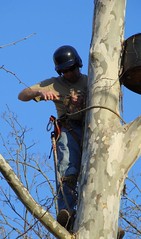
...then gently lowered to the ground to let wildlife photographers get photos of this bundle of grit and attitude that they have been obsessively watching for weeks:

As luck would have it, an orphaned owlet needed another nest, and she was brought out to compare with Owlet #1:

Meet your new sister:
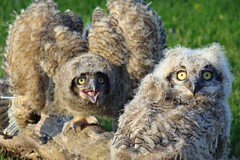
They are approximately the same age, and feeding two babies is more than manageable for the parents. (Great Horned Owls can't count, anyway!)
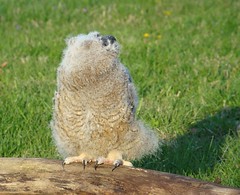
Owlet #2 looks up at her new home.
The youngin's were placed in the nest, and given a free meal. Reports from a certain Owl Sitter say that both chicks are still in the nest and the parents are preening and feeding both owlets.
This little event brought out some weird but friendly people:
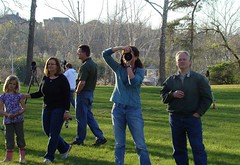
Nina, in a strangely familiar pose....
Also my mother, kids and Kathi, aka KatDoc:

I made everyone strike a pose that seems to have become a tradition...Everybody POINT!!!
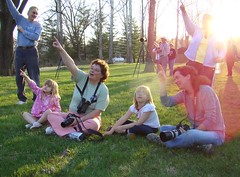
Thursday, April 16, 2009
A day like SourPatch Kids, but in reverse
Filled with birds and bugs and a project.
It started with a Phoebe near the river.
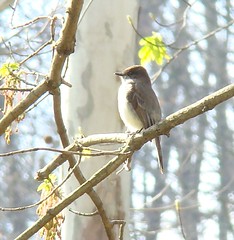
I always get phoebes and peewees mixed up visually. I didn't have my field guide with me, but I had my BirdJam. (Hi, Jay!!!)
I played the phoebe call and this sweet little bundle of bravado sang it back to me.
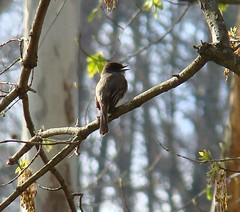
At the same place on the river, a pair of wood ducks were checking out the massive old sycamores for a nest site.
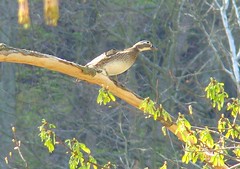
Wood ducks astonish me every time I see one in a tree. I should be used to it by now, being a birder for 7 years...but a duck in a tree. It's weird and wonderful to see. I mean, how do they hang on??? They have...well, DUCK FEET!
I watched the female as she went from tree to tree. She didn't walk along the branches like a raptor would, or any other bird who normally perches up there. If she wanted to move down the branch, she would think about it really hard, bouncing her neck up and down, and then do a half-hop, half-flap to another spot. I laughed out loud quite a few times. The male let her do the house-shopping, and when she got too far away, he would leisurely follow.
Reading up on them at the Cornell All About Birds website, I learned that the babies can jump from heights of 89 m (290 feet!!!) without injury. Wow. I've seen documentaries that show the wee little darlings do their version of base jumping, but 290 feet? Holy Crap!
And the nest is lined with down from the female's breast. Imagine yanking stuff off yourself to care for your baby. I guess breast-feeding comes pretty close.
Later, a towhee visited our feeders.
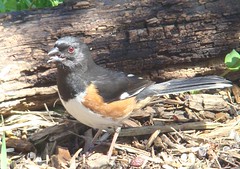
They are a rare treat here, smack dab in the middle of our subdivision. No one but us has the necessary cover for them to feel comfortable. It's a shame, too. Lots of our neighbors have bird feeders, but they live on these wide, vast....green carpets with no bird cover to speak of.
The visit from the towhee got me thinking of a project I wanted to do. I got the idea from a book I received from Lynne's GIVEAWAY. Click here if you want to read the book. It's right up your alley if you are thinking of becoming a rehabber.
Voila. A Bug Pit:

(If you don't know what one is, it's just another way to feed the birds.)
I removed all the grass from the area, filled it in with nice, juicy organic soil (compost) and lots and lots of earthworms, centipedes, slugs, pill bugs....
Lorelei helped.

We then covered everything with leaves, to encourage birds to forage and do their kick-scratch thing. The only leaves we could find were dry, so we watered it down.

Note the purple purse. Even if she's gardening, accessories are important.
The girls are quite fond of turning over rocks and logs to search for insects, so now whenever they find something, it can go in the Bug Pit.
But. Heavy sigh. My dumb, dumb neighbors....
I went up to the top of the street to wait for Isabelle's bus, and the lawn on the corner was being.....treated.

TruGreen? ChemLawn?
Spray-Everything-With-Poison- so nothing can live there but GRASS- people?
I truly don't understand why people pay for this service. Honestly. I grew up on 14 acres of pure, untreated land and I could still do somersaults in the grass. In the current economy, people are PAYING for POISON? Kill ALL the bugs? Even the GOOD ONES?
Let me get this off my chest. Here's how it goes. You "treat" your lawn to this cocktail of gunk, which kills all the beneficial bugs. And then you need MORE poison to kill what the beneficial bugs would eat for you...for free. Nearly everyone on our street employs at least some kind of poison-service. When our direct neighbors get visited by the Scott's guy, I stand by the window and glare at him. When he gets too close to our fence, I find a reason to go outside, to my car or something, and give him a bit of the Stinky Eye. Keep that crap on your side!
What about fertilizers? WTF? You WANT your grass to grow faster and thicker? So you have to mow it more OFTEN? So you can pay for MORE gasoline and belch out MORE fumes into a rapidly thickening atmosphere?
Well, we have all the bugs. And we are happy about it. And so are our birds.
If Geoff would let me, I would kill ALL of our grass, plant native ground-cover and just grow native shrubs and trees. And wildflowers. And seed-producing plants.
FIFTY NINE bird species and counting, on our little patch (3/4 of an acre!) of Heaven, stuck in the middle of Suburban Hell.
Okay. I went on a rant there.
To leave you with something sweet....tomorrow, GHOW chick banding!
Tuesday, April 14, 2009
My kids are COOL. Period.
And occasionally, the muse strikes her and she draws. It's usually things that happened that day, or a wish, or a rant about something Lorelei did.
: )
Tonight, she drew me a picture.

A Steller's Sea Eagle.
Note her notation at top left:
Live: Tundra
Diet: Fish
She told me that the fish making an "O" with its mouth is the one that is about to be eaten.
Also note the buzzing insect flying over all the fish, and the fish are jumping to try
and catch it.
She even made the eagle's eye "fierce".
MY KIDS ARE COOL.
Monday, April 13, 2009
Things I've seen lately

Thanks to Nina and her Caudata-philia, I pay attention to little squirmy things in ponds, instead of just writing them off as tadpoles.
Also at the CNC, a newly-minted butterfly:
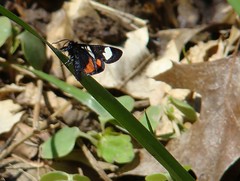
I thought this was a silver-spotted skipper, but looking at photos of them, I see that the white should be on the hindwing, not the forewing. Anyone want to chime in? It was super-tiny.
I got my very own picture of the Lake Isabella GHOW chick:
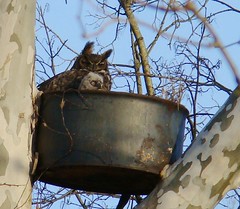
Late afternoon light sure does help when taking photos.
The mourning dove that got away:
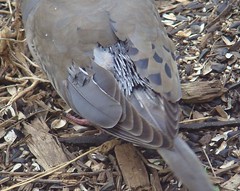
The other day, I saw what I assumed was a Cooper kill on the roof of the house. Throughout the day, dove feathers would drift down onto the front porch. Then later, I saw this picked-apart dove, very much alive and rummaging under the feeders. One tail feather left, and a rump that had been ripped nearly clean.
Speaking of Coops...I was alarmed tonight to see a chickadee sitting completely vertical on the edge of a feeder. He didn't look at me as I moved from window to window to check him out. He was staring across the yard, and I followed his line-of-sight...to a small male Cooper's hawk in a tree. I tried to slip out to the car to get my camera, but spooked the Coop away. Damn. But the chickadee lived to "chickadee-dee-dee" another day.
My surprisingly robust orchid:

After spending the winter as a nondescript stub, this crazy plant has exploded.
I took this photo a few days ago, when there were 12 blossoms. There are 15 today. With more buds ready to open.
I had to stake the darn thing to keep it from falling over!
Thank you Julie, for turning me on to orchids!
Thursday, April 09, 2009
Have cage, will adopt
Kathi called and left a message the other day...
"Hey, Susan. It's Kathi. Look, I have this client who has a rat that she can't keep. Her son has a really serious allergy to the rat and they need to find a home. The rat's name is Junior, which I thought you would appreciate. If you're interested, give me a call."
She hadn't even finished the message before I had made up my mind.
Here's Junior:
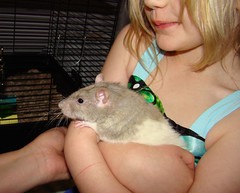
He's quite pretty...a chinchilla-like gray head. He's also extremely overweight, so he's now on a diet of lab blocks, with very spare treats.
*If you are going to have a pet rat, please don't give them the seed-filled, fat-slathered "gourmet" food that is sold in the pet stores. Get the LAB BLOCKS.*
He is very friendly, but needs a bit of socialization.

*If you are going to have a pet rat, get more than ONE. They are social animals who NEED to be with others. Just don't put males and females together. *
Junior came with a mansion (a three-level ferret cage!) and a note from the 9-year old boy whose heart was broken when Junior had to leave.
We introduced him to a few of our rats (Stanley, George and Cutie) but Junior seems to be a chewer. Geoff started yelling the other night: "Aiiiii! Susan! Help! Rats are out of their cages! Aiiii!"
The cage had had a few chew holes in the corners, but I didn't think twice about it. Duh.
We corralled all of them back into their places, but it was a tense few minutes.
Junior is now in a metal cage with a few roomies to keep him company.
We can't seem to get below 8 rats. One dies, another comes along.
Sigh.
Feel free to now roll your eyes and say to yourself, "Man. That Susan is crazy. "
Sunday, April 05, 2009
One sweet little fuzzy head
The official count of chicks in the Lake Isabella Great Horned Owl nest stands at ONE. (The chick is that whitish-gray fuzz on the left of the can.)
(Photo by Roman J. (Jack) Verdin)
I watched with Jack for quite a while, and he promised that the adult feeds the chick every hour or so. I didn't get to see any action today, but I'm sure he's telling the truth. He's the Unofficial OwlSitter.
(And he reads the blog. Hi, Jack!)
Wednesday, April 01, 2009
Real things I saw today, even though it's April Fool's Day
Being plugged in to the avian world makes us privy to a whole host of interesting things. We can marvel at a new bird, ponder a behavior. I saw lots today.
It started with a new yard bird:

Yard bird #59. Brown thrasher. It was kick/scratching under the feeders, then took off for the big maple.
And it was singing. Glorious.
A yellow-rumped warbler landed right next to my car at Lake Isabella, and just looked at me.
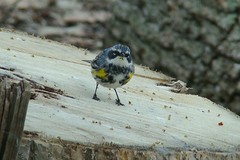
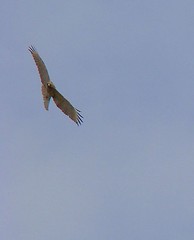
Three red-shouldered hawks were circling the yard and calling out in their wonderfully screamy voices.
Gratuitous cute kid/dog photo:
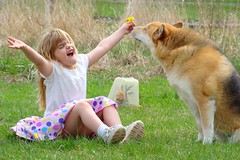
Lorelei was singing, as usual, waving her newly-acquired dandelion. And Hooper leaned in for a sniff.
Nellie was keeping her eye on me, as usual.

"Where's Mom? Oh, there she is. Is she going to get up? I better be ready. Mom? Need me?"
She is my shadow...always near and always worried that I might disappear.
This is Roxy:

She is a Tibetan Yak-Dog.
April Fools. She belongs to Swami. (And she's a Shetland Sheepdog)
Being a long-haired breed, this dog makes lots and lots of loose hair. Lorelei and I brushed her, Hooper, Nellie and whatever cat we could grab and stuffed all that hair into a cardboard tube and hung it outside (birds will use it to line their wee sweet nests)
I wasn't back in the house 10 seconds before someone landed and started plucking:

Tufted titmouse

Bearded titmouse

It was so cool to watch. I've left hair out there before, but usually I just brush the dogs outside and let the hair float away. This was fun!
The titmouse left and a white-breasted nuthatch took its place.
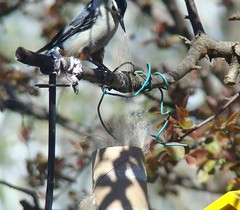
Each bird would grab some with its beak, then maneuver it around, grabbing some with its feet, then rearranging and grabbing it again with the beak. All this grabbing and rearranging helped them carry as much as possible. Birds are just so efficient.
